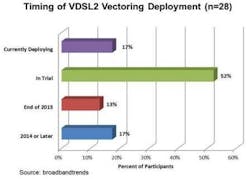Survey confirms operator demand for VDSL2 vectoring
Nearly 70% of operators interviewed say they are either in trial or actively deploying VDSL2 vectoring technology, according to a recent global survey by market research firm Broadbandtrends LLC.
VDSL2 vectoring is a noise-cancellation technology that enables operators to significantly increase the speeds offered over their existing copper infrastructure. Indeed, the overwhelming driver for deployment of VDSL2 vectoring is the ability to offer faster speeds, with most operators planning to offer speeds between 50 and 100 Mbps, the survey revealed.
As it would be extremely difficult to support such data rates on many copper networks without the combination of VDSL2 and vectoring, the availability of the technology could be seen as an impediment to the adoption of fiber to the home (FTTH).
“Although nearly every fixed line telco would like to deploy fiber to every end point in their network, there are financial realities that will not allow this to happen in a timely fashion,” commented Teresa Mastrangelo, principal analyst with Broadbandtrends. “VDSL2 vectoring provides operators with an interim solution that will enable significantly faster speeds over their existing copper network in a matter of months, rather than years.”
Broadbandtrends’ report, VDSL2 Vectoring Deployment Strategies and Vendor Leadership, analyzes the VDSL2 vectoring strategies of incumbent and competitive operators around the world. The analyst firm interviewed service providers during March and April 2013, via telephone, in-person and online, regarding their plans for VDSL2 vectoring deployment. The respondents, from all major regions, represent 50% of all deployed DSL lines at the end of 2012, Broadbandtrends asserts.
Participants provided input on a range of areas including:
- timing of deployments
- key drivers for deployment
- key challenges
- expected speed offerings
- average loop lengths for deployment
- average node size
- co-existence with other technologies.
Although the compatibility of customer premises equipment (CPE) was the most cited challenge to the implementation of VDSL2 vectoring, responses varied by region, with regulatory concerns ranking high in Europe, Middle East, and Africa (EMEA); loop lengths a significant concern in North America; and cost worrying respondents from Central and Latin America (CALA) and Asia Pacific.
The global survey also includes respondent ratings for 11 vendors: Alcatel-Lucent, ADTRAN, Calix, ECI, Ericsson, Huawei, Iskratel, KEYMILE, NEC, Zhone, and ZTE. Alcatel-Lucent received top marks for VDSL2 DSLAMs from respondents and is the most recognized, followed by Huawei.
For more information on FTTx/access systems and suppliers, visit the Lightwave Buyer’s Guide.

